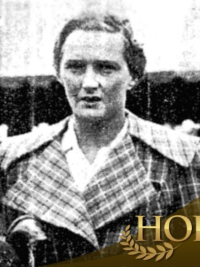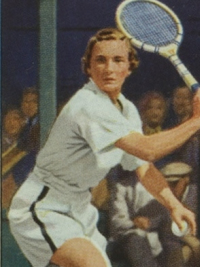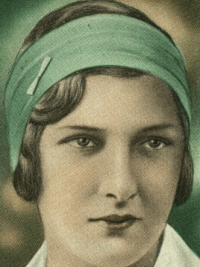Helen Hull Jacobs
| Born |
Subscribe now
This information and data is not available because you are not our subscriber yet.
Please click here and get full access to the entire database! |
|---|---|
| Died | |
| Class of HOF | |
| Plays | |
| Bio | Jacobs was born in Globe, Arizona, and was Jewish. Her parents, Roland and Eula Jacobs, moved the family to San Francisco in 1914. Jacobs had a powerful serve and overhead smash and a sound backhand, but she never learned to hit a flat forehand, despite her friendship, and some coaching, from Bill Tilden. Like both her Wightman Cup coach Hazel Hotchkiss Wightman and her archrival Helen Wills Moody, she grew up in Berkeley, California, learned the game at the Berkeley Tennis Club, pursued her undergraduate degree at the University of California, Berkeley and was inducted into the Cal Sports Hall of Fame. Jacobs won five Grand Slam singles titles and was an eleven-time Grand Slam singles runner-up. Six of those losses were to Helen Wills Moody. Jacobs's only victory over Moody was in the final of the 1933 U.S. Championships. Moody retired from the match with a back injury while trailing 3–0 in the third set to a chorus of boos from the audience who believed that Moody quit the match merely to deny Jacobs the satisfaction of finishing out her victory. It was reported by many witnesses after the match that Moody still planned to play her doubles match later that afternoon but was advised against it. Years later, Moody confirmed her injury, saying, "My back is kind of funny. The vertebra between the fourth and fifth disk is thin. When the disk slips around it's intolerable. It rained the whole week before that final match. I lay in bed, and that was bad because it stiffened worse. I just couldn't play any longer, but I didn't say anything because it would look like an excuse." Jacobs almost defeated Moody again when she had match point at 6–3, 3–6, 5–3 in the 1935 Wimbledon Championships singles final but a mishit on a short lob, which she decided to let bounce, cost her the point and four games later the match. In the 1938 Wimbledon final against Moody, Jacobs turned her ankle at 4–4 in the first set and hobbled around the court for the remainder of the match, with Moody winning the final eight games and the second set lasting a mere eight minutes. When asked after the match why she did not accept Hazel Wightman's on-court advice to quit the match after the injury, Jacobs said that continuing was the sporting thing to do so that Moody could enjoy the full taste of victory, an obvious allusion to Moody's retirement from the 1933 U.S. final. Moody said, "I was very sorry about Helen's ankle. But it couldn't be helped, could it? I thought there was nothing I could do but get it over as quickly as possible." In total, Jacobs lost 14 of the 15 career singles matches she played against Moody. Jacobs won three Grand Slam women's doubles titles and one in mixed doubles. She was the runner-up at six Grand Slam women's doubles tournaments and one Grand Slam mixed doubles tournament. She won the singles and women's doubles titles at the Italian Championships in 1934. Often overshadowed by her storied rival Helen Wills Moody but seldom if ever losing faith in her own capabilities, Jacobs made the most of her opportunities and came away with some high honors. For four years in a row, from 1932-35, she was the singles victor at her native U.S. Championships. In 1936, she was victorious at Wimbledon. Although her game did not feature any dazzling strengths and her ground game was limited, she was highly competent at the net. Moreover, she was a first-rate match player. According to A. Wallis Myers and John Olliff of The Daily Telegraph and the Daily Mail, Jacobs was ranked in the world top ten from 1928 through 1939 (no rankings issued from 1940 through 1945), reaching a career high of World No. 1 in those rankings in 1936. With the exceptions of 1930 and 1938, Jacobs was included in the year-end top ten rankings by the United States Tennis Association from 1927 through 1941. She was the top ranked U.S. player from 1932 through 1935. Jacobs was a member of the U.S. Wightman Cup team from 1927 through 1937 and again in 1939. Her lifetime record was 19–11. In 1933, Jacobs became the first woman to break with tradition by wearing man-tailored shorts at Wimbledon. While she was still playing tennis, Jacobs became a writer. Her first books were Modern Tennis (1933) and Improve Your Tennis (1936). She also wrote fictional works, such as Storm Against the Wind (1944). Her autobiography Beyond the Game appeared in 1936. In 1949 she published Gallery of Champions, a collection of biographies of female players, which she dedicated to Molla Mallory. Jacobs was named Associated Press Female Athlete of the Year in 1933. She was inducted into the International Tennis Hall of Fame in 1962. |
| Misc | Subscribe now |
| Tournament | AO | RG | W | US | Win-Loss |
|---|---|---|---|---|---|
|
Subscribe now
This information and data is not available because you are not our subscriber yet.
Please click here and get full access to the entire database! |
|||||


